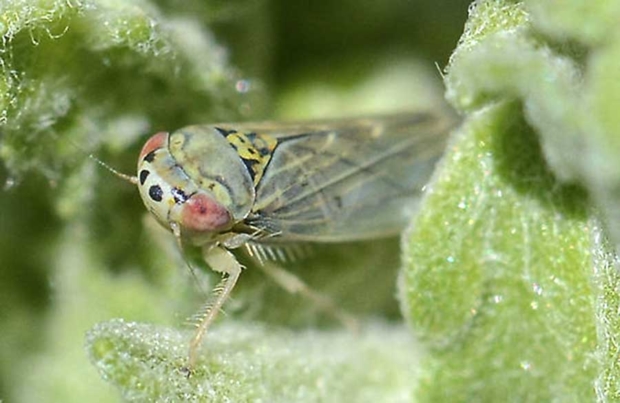
A Colladonus geminatus leafhopper. Researchers have found this species of leafhopper can carry Western X, a pathogen linked to little cherry disease. Photo courtesy of Tamara Feenstra
The growing incidence of little cherry disease in Pacific Northwest orchards prompted researchers to begin a project last year to survey leafhoppers that might be transmitting Western X, one of three pathogens associated with the disease.
Their goal: learn exactly which species of leafhopper, if any, might be transmitting the pathogen, as well as the leafhoppers’ seasonal patterns of movement between affected orchards and alternate host plants, to ultimately begin to develop management strategies.
In the first year of the three-year project, the research turned up a couple of key findings. First, researchers discovered that two leafhopper vectors — Colladonus geminatus and C. reductus — were the most abundant species on sticky cards in cherry trees and in habitat outside the orchards. Molecular diagnostic testing results confirmed that both species can carry Western X phytoplasma.
“We suspect that these two species are the main culprits for spreading Western X,” Holly Ferguson, a Washington State University integrated pest management extension specialist, told growers at the Washington Tree Fruit Research Commission’s Cherry Research Review in November.
Second, the research whittled the likely neighboring host plants to alfalfa and sage plants.
Timing also proved crucial. The positive samples for both species were primarily found in the orchard during two periods of time: early May and late July/early August.
2016 surveys
The 2016 leafhopper surveys in cherry producing regions yielded data in three Washington counties — Yakima, Grant and Benton — but not in the four blocks sampled in Chelan County. Very few leafhoppers were found there, and the researchers learned later that the sites had been subjected to insecticide sprays both pre- and post-harvest.
Researchers gathered 218 C. geminatus leafhopper samples and 168 C. reductus samples. Molecular diagnostic testing confirmed that both species can carry the Western X phytoplasma. While C. geminatus is known to be a vector of Western X in Washington, little is known about the vector status of C. reductus, requiring additional study. They also found cherry leafhopper, Fieberiella florii, in two locations.
That leafhopper species is particularly difficult to capture as it is nocturnal and is not attracted to yellow sticky cards. However, Fieberiella florii is a known, significant vector of Western X in California sweet cherries.
Of the C. geminatus samples, researchers found positive samples in the extra orchard habitat, such as alfalfa, sageland and roadside weeds, in late April, early May. Later in the season, Western X positive leafhoppers were discovered in the neighboring orchards.
Of the 168 C. reductus samples, researchers found a lot of positive samples in the springtime, both in the orchard and neighboring habitat, with an uptick of positive samples in late July/early August in the orchards.
Since most of the positive samples of these two species were collected in neighboring habitat in late April to early May, that suggests that springtime reservoirs of the pathogen are outside the orchard, Ferguson said. At the same time, the upsurge in positive samples later in the summer “may be explained by the simultaneous increase in Western X in the cherry trees at that time of year.”
Late in the season, leafhopper abundance was comparatively low in extra orchard habitats.
Going forward
In 2017, the researchers will conduct leafhopper sampling from March to October in Western X affected cherry orchards in four Washington counties to determine leafhopper distribution by species and peak activity periods, and they will continue their work to identify host plants outside the orchard.
In addition, the researchers successfully established a C. reductus colony on celery seedlings in the first year of the study. They aim to use those leafhoppers for transmission studies in the laboratory.
Funding for this project, in part, comes from a larger grant awarded by the National Clean Plant Network and through the Washington Tree Fruit Research Commission.
– by Shannon Dininny






Leave A Comment